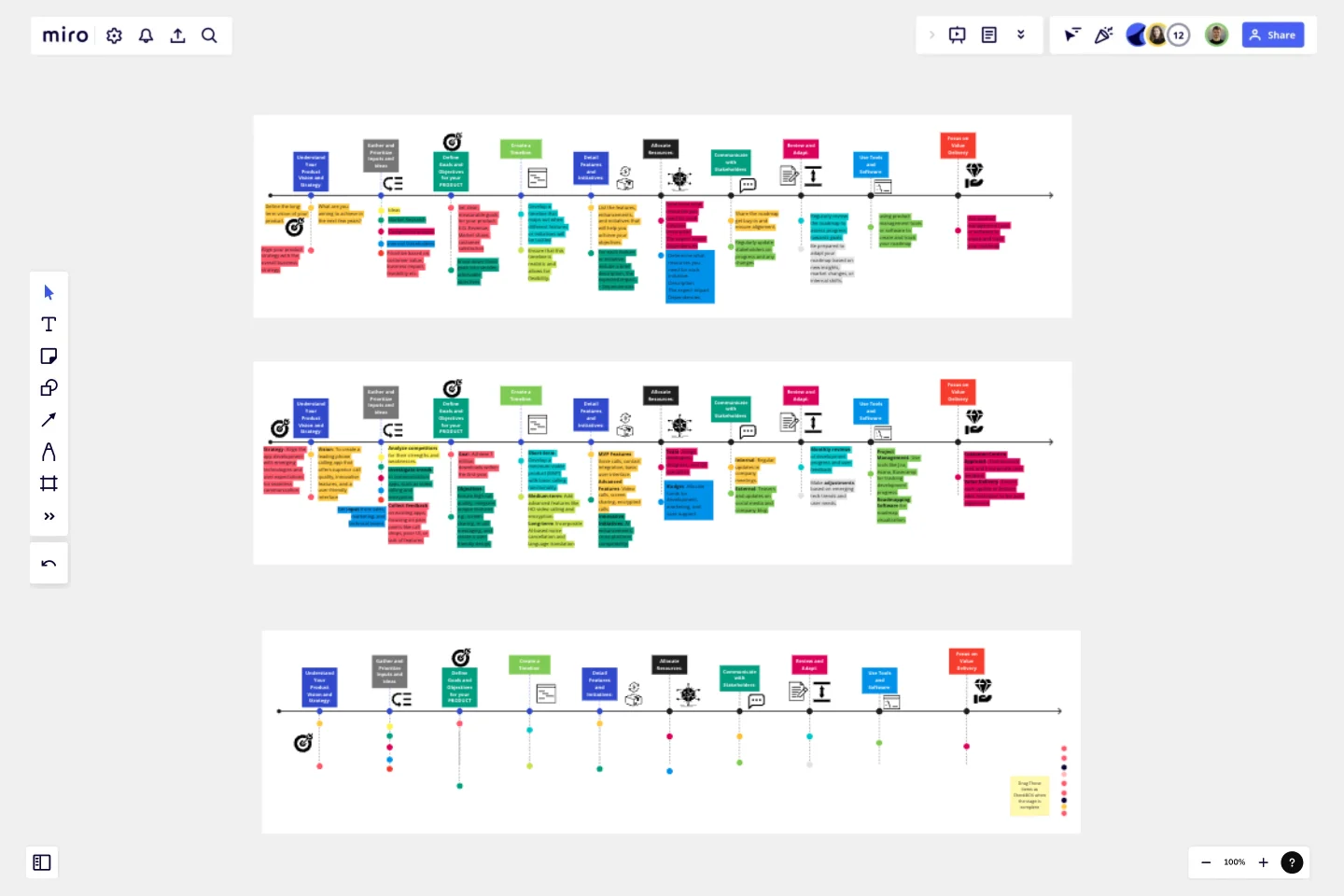Product Roadmap by Mark V. Smetanin
Blueprint to Success: Mastering Product Roadmap.
This framework guides product managers through the systematic process of creating an effective and adaptable product roadmap, ensuring alignment with business goals and market dynamics.
Creating a product roadmap as a product manager involves several key steps. Here's a general guide to help you through the process:
Understand Your Product Vision and Strategy:
Define the long-term vision of your product. What are you aiming to achieve in the next few years?
Align your product strategy with the overall business strategy. Understand how your product contributes to the broader goals of the company.
Gather and Prioritize Inputs:
Collect insights from various sources like market research, customer feedback, competitive analysis, and internal stakeholders.
Prioritize these inputs based on factors like customer value, business impact, feasibility, and alignment with your product vision.
Define Goals and Objectives:
Set clear, measurable goals for your product. These could be related to revenue, market share, customer satisfaction, etc.
Break down these goals into smaller, achievable objectives.
Create a Timeline:
Develop a timeline that maps out when different features or initiatives will be tackled. This includes short-term, medium-term, and long-term plans.
Ensure that this timeline is realistic and allows for flexibility.
Detail Features and Initiatives:
List the features, enhancements, and initiatives that will help you achieve your objectives.
For each feature or initiative, include a brief description, the expected impact, and any dependencies.
Allocate Resources:
Determine what resources (team members, budget, technology, etc.) are needed for each initiative.
Plan for resource allocation keeping in mind the capacity of your team and budget constraints.
Communicate with Stakeholders:
Share the roadmap with internal stakeholders (teams, executives) to get buy-in and ensure alignment.
Regularly update stakeholders on progress and any changes to the roadmap.
Review and Adapt:
Regularly review the roadmap to assess progress towards goals.
Be prepared to adapt your roadmap based on new insights, market changes, or internal shifts.
Use Tools and Software:
Consider using product management tools or software to create and track your roadmap. Tools like Aha!, ProductPlan, or Roadmunk can be useful.
Focus on Value Delivery:
Always keep the focus on delivering value to customers and the business.
Be open to feedback and iterate on your product based on real-world usage and changing needs.
This template was created by Mark V. Smetanin.
Get started with this template right now.
Strategic Action Framework
Works best for:
Roadmap, Planning, Mapping
The Strategic Action Framework template provides a structured approach for developing and implementing strategic initiatives. By defining goals, strategies, and action plans, teams can align their efforts with organizational objectives and drive progress towards desired outcomes. This template fosters collaboration and accountability, ensuring that strategic initiatives are executed effectively and deliver measurable results.
App Wireframe Template
Works best for:
UX Design, Wireframes
Ready to start building an app? Don’t just imagine how it will function and how users will interact with it—let a wireframe show you. Wireframing is a technique for creating a basic layout of each screen. When you wireframe, ideally early in the process, you’ll gain an understanding of what each screen will accomplish and get buy-in from important stakeholders—all before adding the design and content, which will save you time and money. And by thinking of things in terms of a user’s journey, you’ll deliver a more compelling, successful experience.
Product x Marketing Roadmap
Works best for:
Product Management, Roadmap
Align product development with marketing strategies using the Product x Marketing Roadmap. This template helps you coordinate product launches, marketing campaigns, and key milestones. Use it to ensure both teams are on the same page, maximizing the impact of your product releases. Ideal for product managers and marketing teams aiming to synchronize their efforts and achieve cohesive, successful product launches and campaigns.
Product Management - Product Flow
Works best for:
Product Management, Planning
Product Management - Product Flow template enables product managers to visualize and streamline product development processes. By mapping out key stages, tasks, and dependencies, this template enhances workflow transparency and coordination. With features for identifying bottlenecks and optimizing resource allocation, it empowers teams to improve efficiency and accelerate product delivery. This template serves as a valuable tool for ensuring smooth product development and launch processes, ultimately driving better outcomes.
Product Vision Statement
Works best for:
Product Management, Planning
The Product Vision Statement template helps product teams articulate clear and inspiring visions for product development. By defining long-term goals, market aspirations, and customer value propositions, this template aligns teams around a shared vision for success. With sections for outlining strategic objectives, guiding principles, and success metrics, it provides clarity and direction for product development efforts. This template serves as a compass for product teams, guiding them towards meaningful outcomes and driving innovation and growth.
Define Your Product's Target Audience
Works best for:
Product Management, Planning
Too broad an audience? Or trying to target too many audiences? This is a certain path to product failure.
